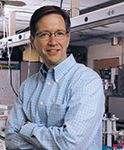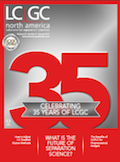Life in the Fast Lane with High-Throughput Separations
Special Issues
Robert T. Kennedy

The field of separations can benefit by addressing challenges of complex samples, miniaturization, and faster assays. In this article, I consider the issue of speed. Fast separations mean different things to different scientists so it is worth considering these different points of view. Fast can mean rapid turnaround for a specific assay, such as one that may be used in an emergency clinical setting or process analytical chemistry, where a known chemical is to be measured and action will be taken based on the result. Or fast can mean providing rapid information but on ever-changing targets. A good example is research and development (R&D) in the pharmaceutical industry. As new compounds become of interest, assays need to be quickly developed and then used for thousands of samples. Fast can also mean high-throughput where 103–106 assays must be performed in a short period of time. Examples include genome sequencing, screening reactions, and screening libraries for active compounds (such as drug candidates).
Separations methods are often discarded, or never considered, when speed of analysis is truly critical. Sensors, fluorescence assays, and ambient ionization methods with mass spectrometry (MS) have become preferred methods for such assays. This trend is apparent despite the fact that otherwise separations are often the “go-to method” because of the substantial improvement in data quality from using separations coupled to spectroscopy, MS, or electrochemistry. Reasons for overlooking separations when speed and throughput are needed include traditionally slow analysis times, the need for sample preparation, complexity of instrument maintenance, and lack of options for parallel operation (at least for chromatography). Overcoming these limitations to enable rapid and high-throughput separations assays could revolutionize many fields including chemical synthesis, biological sensing, diagnostics, and drug discovery.
Research in the past few decades has greatly advanced the speed of the actual separation. Gas chromatography (GC), high performance liquid chromatography (HPLC), and capillary electrophoresis (CE) with subsecond separation times have been demonstrated. Although peak capacity is often lost when going to such extreme speeds, it is possible to achieve a respectable peak capacity of 50 with impressive separations times less than 10 s, especially using CE and GC. These results show that it is indeed feasible to achieve high-quality separations in times that compete with other “fast” analytical techniques.
Looking forward, it is apparent that numerous hurdles must be overcome to improve the applicability, utility, and accessibility of this speed. Important issues to address include time for method development and sample preparation, developing injectors and sample manipulation that can keep pace with the separation, reequilibration times (chromatography columns), stability (for thousands of assays), and detectors that can record spectra under the conditions of the fast assays. In particular, it would be exceptionally powerful to have mass spectrometers that can collect spectra on the millisecond-wide peaks that can be achieved with fast separations. As discussed below, research groups working on these issues have been successful in bringing the power of fast separations to bear on both old and new problems.
Analytical chemists in pharmaceutical R&D are regularly presented with new drug candidates that need assays. Chromatography method development time can be the bottleneck in providing the analytical information needed in the fast-paced world of pharmaceutical R&D. Pharmaceutical companies have invested in methods that allow rapid selection of the proper column or conditions for a given separations problem. At the 45th International Symposium on High Performance Liquid Phase Separations and Related Techniques (HPLC 2017) in Prague, Czech Republic, Kelly Zhang of Genentech presented a novel two-dimensional (2D) platform that effectively eliminated the need for method development for many of the common problems faced in the pharmaceutical industry, generating a “fast” method for that environment (1).
Chemical synthesis research increasingly relies on high-throughput experimentation to discover new reactions and catalysts and to optimize reactions. A team at Merck has been active in integrating chromatography into this workflow (2,3). Recognizing that injections and sample handling can be limiting for high-throughput, they used the multiple injection in a single experimental run (MISER) technique to allow ~10-s cycle times. This technique has been used to perform more than 1500 different chemical synthesis experiments in a single day with HPLC data for each experiment. Further improvements in injection methods are needed to further enhance the throughput of this approach.
High-throughput screening in drug discovery is dominated by fluorescence assays; however, the power of a separation can often be useful, as illustrated by the success of the lab-on-chip systems for screening (4). Although microchip electrophoresis can achieve subsecond separations, rapidly introducing new samples to a chip limits actual throughput. We have recently demonstrated that droplet microfluidics may be a useful tool for enabling fast sample manipulation and injection, achieving 1400 assays in 46 min for an enzyme screen (5).
Protein biochemistry routinely uses western blot for assays. Although fast protein separations by microchip CE has been known for two decades, only recently have groups considered the other aspects needed for fast western blots and integrated them with fast separation (6). Achievements in this area are pointing toward high-throughput western blots with single-cell sensitivity for protein analysis.
It is apparent that achieving useful, rapid separations requires a holistic view that considers all steps of the analysis, not just the actual separation step. Decreasing injection time and eliminating sample preparation are examples of actions that are needed to enable truly fast and high-throughput separations. The examples above show that microfluidics is a potential route for overcoming some of the “extracolumn” limitations of separations speed and throughput.
Achieving rapid and high-throughput separations will add a new tool to the analyst’s armamentarium. Imagine the utility of a chromatograph that required no sample preparation and no method optimization but was “smart” enough to achieve these front-end tasks quickly and efficiently. Fast assays could be used more routinely for clinical diagnostics and threat detection. Integration of fast separations with sampling would allow biological sensing and process monitoring. Faster, and truly high-throughput separations, would be an important new tool in chemical biology, catalysis discovery, and drug discovery by allowing high-throughput screening.
References
- K. Zhang, “Multiplexed mLC-nLC for Comprehensive Impurity Profiling: A Method Development ‘Free’ Platform,” presented at the 45th International Symposium on High Performance Liquid Phase Separations and Related Techniques (HPLC 2017), Prague, Czech Republic, 2017.
- K. Zawatzky, C.L. Barhate, E.L. Regalado, B.F. Mann, N. Marshall, J.C. Moore, and C.J. Welch, J. Chromatogr. A 1499, 211–216 (2017).
- A. Buitrago Santanilla, E.L. Regalado, T. Pereira, M. Shevlin, K. Bateman, L.C. Campeau, J. Schneeweis, S. Berritt, Z.C. Shi, P. Nantermet, Y. Liu, R. Helmy, C.J. Welch, P. Vachal, I.W. Davies, T. Cernak, and S.D. Dreher, Science347(6217), 49–53 (2015).
- A. Card, C. Caldwell, H. Min, B. Lokchander, X. Hualin, S. Sciabola, A.V. Kamath, S.L. Clugston, W.R. Tschantz, W. Leyu, and D.J. Moshinsky, J. Biomol. Screen14(1), 31–42 (2009).
- E.D. Guetschow, D.J. Steyer, and R.T. Kennedy, Anal. Chem.86(20), 10373–9 (2014).
- A.J. Hughes and A.E. Herr, Proc. Natl. Acad. Sci. U.S.A.109(52), 21450–5 (2012).
Robert T. Kennedy is the chair of the Chemistry Department, a Hobart Willard Distinguished University professor, and a professor of chemistry and pharmacology at the University of Michigan in Ann Arbor, Michigan.

Investigating 3D-Printable Stationary Phases in Liquid Chromatography
May 7th 20253D printing technology has potential in chromatography, but a major challenge is developing materials with both high porosity and robust mechanical properties. Recently, scientists compared the separation performances of eight different 3D printable stationary phases.
Detecting Hyper-Fast Chromatographic Peaks Using Ion Mobility Spectrometry
May 6th 2025Ion mobility spectrometers can detect trace compounds quickly, though they can face various issues with detecting certain peaks. University of Hannover scientists created a new system for resolving hyper-fast gas chromatography (GC) peaks.
University of Oklahoma and UC Davis Researchers Probe Lipidomic Profiles with RP-LC–HRMS/MS
May 6th 2025A joint study between the University of Oklahoma Health Sciences Center (Oklahoma City, Oklahoma) and the UC Davis West Coast Metabolomics Center (Davis, California) identified differentially regulated lipids in type 2 diabetes (T2D) and obesity through the application of reversed-phase liquid chromatography-accurate mass tandem mass spectrometry (RP-LC-accurate MS/MS).

.png&w=3840&q=75)

.png&w=3840&q=75)



.png&w=3840&q=75)



.png&w=3840&q=75)


















